Design Considerations of Low Bypass Ratio Mixed Flow Turbofan Engines with Large Power Extraction
Abstract
:1. Introduction
2. Materials and Methods
- Inlet
- Fan (LPC)
- Splitter
- High pressure compressor (HPC)
- Burner
- High-pressure turbine (HPT)
- Low-pressure turbine (LPT)
- Unifier (Mixer)
- Afterburner
- Nozzle
- Compatibility of work
- Compatibility of flow
- Compatibility of rotational speed
- Overall pressure ratio (OPR)
- Turbine inlet temperature (T4)
- In the first results part, Section 3.1, the thermodynamic cycle is defined by one single design point.
- The second part, Section 3.2, illustrates how a parametric variation of design OPR affects the engine’s ability to handle large power extraction.
3. Results
3.1. Single Design Point Evaluation
- Reference case—No power extraction
- Power extraction case—900 kW power extraction from the HPT
3.2. Effect of Varying Design OPR
4. Discussion
Author Contributions
Funding
Acknowledgments
Conflicts of Interest
Nomenclature
| A/B | Afterburner |
| ACE | Adaptive cycle engine |
| ALT | Altitude, measured in relation to sea level conditions |
| ARP | Aerospace Recommended Practice |
| BLI | Boundary layer ingestion |
| CENTRELINE | Concept validation study for fuselage wake-filling propulsion integration |
| CFS | Convertible fan stage |
| DEW | Directed energy weapon |
| EU | European Union |
| F | Force |
| Fan | Equivalent to LPC in the modeled engine |
| FN | Net thrust |
| FPR | Fan pressure ratio |
| GESTPAN | General stationary and transient propulsion analysis |
| HEP | Hybrid electric propulsion |
| LPC | Low-pressure compressor |
| HPC | High-pressure compressor |
| HPCPR | High-pressure compressor pressure ratio |
| HPT | High-pressure turbine |
| LPT | Low-pressure turbine |
| M | Mach number |
| N | Number of turns |
| OPR | Overall pressure ratio |
| PT | Stagnation pressure |
| P | Power |
| S | Entropy |
| SAE | Society of automotive engineers |
| SFC | Thrust specific fuel consumption |
| T | Stagnation temperature |
| VCE | Variable cycle engine |
| W | Mass flow |
| Β | Operating line offset relative to backbone in a compressor map |
| βf | Fuel schedule factor, off-design fuel flow relative to the design point fuel flow |
| ηp | Propulsive efficiency |
| ηth | Thermal efficiency |
| θ0 | Dimensionless stagnation temperature |
Appendix A
| ALT | M0 | PT0 | PT2 | T2 | W2 | BPR | PT3 | T3 | PT4 | T4 | PHPT | PT45 | T45 | PLPT | PT5 | T5 | PT8 | T8 | FN | ηth | ηp |
| [m] | - | [kPa] | [kPa] | [K] | [kg/s] | - | [kPa] | [K] | [kPa] | [K] | [kW] | [kPa] | [K] | [kW] | [kPa] | [K] | [kPa] | [K] | [kN] | - | - |
| 610 | 0.0 | 94.2 | 84.2 | 284 | 78.9 | 0.468 | 2280 | 782 | 2190 | 1870 | 0 | 901 | 1410 | 0 | 415 | 1200 | 410 | 991 | 66 | 0.42 | 0 |
| 610 | 0.1 | 94.9 | 86.4 | 285 | 87.6 | 0.447 | 2630 | 808 | 2530 | 1940 | 0 | 1040 | 1470 | 0 | 473 | 1250 | 399 | 2090 | 111 | 0.24 | 0.05 |
| 610 | 0.18 | 96.4 | 90.5 | 286 | 90.4 | 0.452 | 2700 | 807 | 2600 | 1930 | 0 | 1070 | 1470 | 0 | 487 | 1250 | 411 | 2090 | 113 | 0.25 | 0.1 |
| 610 | 0.44 | 108 | 104 | 295 | 104 | 0.449 | 3170 | 835 | 3050 | 2000 | 0 | 1250 | 1520 | 0 | 570 | 1300 | 489 | 2090 | 127 | 0.27 | 0.21 |
| 3048 | 0.775 | 108 | 104 | 303 | 105 | 0.44 | 3290 | 865 | 3160 | 2070 | 0 | 1300 | 1580 | 0 | 590 | 1350 | 514 | 2100 | 128 | 0.31 | 0.31 |
| 7010 | 0.875 | 67.4 | 65.5 | 280 | 65.7 | 0.455 | 1940 | 790 | 1860 | 1890 | 0 | 763 | 1440 | 0 | 348 | 1220 | 294 | 2080 | 78.9 | 0.31 | 0.33 |
| 9144 | 0.9 | 50.9 | 50.4 | 266 | 30 | 0.633 | 657 | 602 | 628 | 1370 | 0 | 257 | 1020 | 0 | 128 | 881 | 128 | 696 | 12.4 | 0.43 | 0.57 |
| 9144 | 1.6 | 127 | 115 | 346 | 88.7 | 0.498 | 2720 | 902 | 2610 | 2120 | 0 | 1080 | 1630 | 0 | 502 | 1400 | 441 | 2120 | 101 | 0.38 | 0.46 |
| 9144 | 0.9 | 50.8 | 49.7 | 266 | 45.8 | 0.485 | 1250 | 722 | 1200 | 1720 | 0 | 492 | 1290 | 0 | 227 | 1100 | 193 | 2060 | 53.2 | 0.29 | 0.34 |
| 9144 | 2.0 | 235 | 183 | 412 | 108 | 0.552 | 3320 | 985 | 3190 | 2260 | 0 | 1320 | 1750 | 0 | 634 | 1520 | 571 | 2130 | 113 | 0.38 | 0.52 |
| 610 | 0.0 | 94.2 | 84.3 | 284 | 77.7 | 0.496 | 2250 | 779 | 2170 | 1930 | 900 | 889 | 1460 | 0 | 415 | 1250 | 410 | 1020 | 66 | 0.42 | 0 |
| 610 | 0.1 | 94.9 | 86.5 | 285 | 87.1 | 0.47 | 2620 | 808 | 2520 | 2000 | 900 | 1040 | 1520 | 0 | 476 | 1300 | 408 | 2080 | 111 | 0.25 | 0.05 |
| 610 | 0.18 | 96.4 | 90.6 | 286 | 90 | 0.473 | 2700 | 807 | 2600 | 2000 | 900 | 1070 | 1520 | 0 | 491 | 1290 | 419 | 2080 | 113 | 0.25 | 0.09 |
| 610 | 0.44 | 108 | 104 | 295 | 103 | 0.467 | 3170 | 835 | 3050 | 2050 | 900 | 1250 | 1560 | 0 | 575 | 1340 | 498 | 2090 | 127 | 0.28 | 0.21 |
| 3048 | 0.775 | 108 | 104 | 303 | 105 | 0.456 | 3300 | 865 | 3170 | 2130 | 900 | 1300 | 1620 | 0 | 596 | 1390 | 524 | 2090 | 128 | 0.32 | 0.31 |
| 7010 | 0.875 | 67.4 | 65.6 | 280 | 65.5 | 0.484 | 1940 | 791 | 1870 | 1990 | 900 | 768 | 1510 | 0 | 354 | 1290 | 301 | 2080 | 78.9 | 0.32 | 0.33 |
| 9144 | 0.9 | 50.9 | 50.5 | 266 | 26.9 | 0.814 | 591 | 594 | 571 | 1680 | 900 | 233 | 1250 | 0 | 124 | 1100 | 124 | 801 | 12.4 | 0.43 | 0.55 |
| 9144 | 1.6 | 127 | 115 | 346 | 88.7 | 0.515 | 2740 | 905 | 2640 | 2190 | 900 | 1090 | 1680 | 0 | 511 | 1450 | 454 | 2110 | 101 | 0.38 | 0.46 |
| 9144 | 0.9 | 50.8 | 49.7 | 266 | 45.4 | 0.53 | 1260 | 725 | 1220 | 1870 | 900 | 498 | 1410 | 0 | 234 | 1210 | 199 | 2060 | 53.2 | 0.3 | 0.34 |
| 9144 | 2.0 | 235 | 183 | 412 | 101 | 0.589 | 3030 | 964 | 2910 | 2260 | 900 | 1200 | 1750 | 0 | 588 | 1520 | 529 | 2130 | 105 | 0.38 | 0.53 |
References
- Rosero, J.A.; Ortega, J.A.; Aldabas, E.; Romeral, L. Moving towards a more electric aircraft. IEEE Aerosp. Electron. Syst. Mag. 2007, 22, 3–9. [Google Scholar] [CrossRef] [Green Version]
- Walters, E.; Iden, S.; McCarthy, K.; Amrhein, M.; O’Connell, T.; Raczkowski, B.; Wells, J.; Lamm, P.; Wolff, M.; Yerkes, K.; et al. INVENT Modeling, Simulation, Analysis and Optimization. In Proceedings of the AIAA Aerospace Sciences Meeting Including the New Horizons Forum and Aerospace Exposition (AIAA 2010-287), Orlando, FL, USA, 4–7 January 2010; p. 3. [Google Scholar]
- Charrier, J.-J.; Kulshreshtha, A. Electric Actuation for Flight & Engine Control System: Evolution, Current trends & future Challenges. In Proceedings of the 45th AIAA Aerospace Sciences Meetings and Exhibit (AIAA 2007-1391), Reno, NV, USA, 8–11 January 2007. [Google Scholar]
- Freeman, J.; Osterkamp, P.; Green, M.; Gibson, A.; Schiltgen, B. Challenges and opportunities for electric aircraft thermal management. Aircr. Eng. Aerosp. Technol. 2014, 86, 519–524. [Google Scholar] [CrossRef]
- MacIsaac, B.; Langton, R. Gas Turbine Propulsion Systems; John Wiley and Sons Ltd.: Chichester, UK, 2011; pp. 63–65, 184–186. [Google Scholar]
- Demel, H.F. Installation of Electric Generators on Turbine Engines; 19840001994; NASA, Lewis Research Center Aircraft Elect, Secondary Power: Cleveland, OH, USA, 1983. [Google Scholar]
- Saravanamuttoo, H.I.H.; Rogers, G.F.C.; Cohen, H.; Straznicky, P.V.; Nix, A.C. Gas Turbine Theory, 7th ed.; Pearson Education Limited.: London, UK, 2017; pp. 101, 127–130, 407–408, 510. [Google Scholar]
- Rolls-Royce Plc. The Jet Engine, 5th ed.; The Technical Publication Department, Rolls-Royce Plc.: Derby, UK, 1996; p. 65. [Google Scholar]
- Guha, A. Optimisation of aero gas turbine engines. Aeronaut. J. 2001, 105, 345–358. [Google Scholar] [CrossRef]
- Roth, B.A.; Mavris, D.N. A Work Availability Perspective of Turbofan Engine Performance. In Proceedings of the 39th AIAA, Aerospace Science Meeting and Exhibit, Reno, NV, USA, 8–11 January 2001. [Google Scholar]
- Giannakakis, P.; Laskaridis, P.; Pilidis, P. Effects of Offtakes for Aircraft Secondary-Power Systems on Jet Engine Efficiency. J. Propuls. Power 2011, 27, 1024–1031. [Google Scholar] [CrossRef]
- Faidi, A. Effect of Accessory Power Take-Off Variation on a Turbofan Engine Performance; Air Force Institute of Technology, Wright-Patterson Air Force Bace: Dayton, OH, USA, 2012. [Google Scholar]
- Slingerland, R.; Zandstra, S. Bleed Air Versus Electric Power Offtakes from a Turbofan over the Flight Cycle. In Proceedings of the 7th AIAA Aviation Technology, Integration and Operations Conference (AIAA-2007-7848-925), Belfast, Northern Ireland, 18–20 September 2007. [Google Scholar]
- Samuelsson, S.; Petit, O.; Merkler, R.; Wortmann, G. Adaptation of a turbofan engine for high power offtakes for a turbo-electric propulsive fuselage concept. In Proceedings of the 24th International Symposium on Air Breathing Engines (ISABE-2019-24215), Canberra, Australia, 22–27 September 2019. [Google Scholar]
- Culley, D.E.; Kratz, J.L.; Thomas, G.L. Turbine Electrified Energy Management (TEEM) For Enabling More Efficient Engine Designs. In Proceedings of the Joint Propulsion Conference 2018, Cincinnati, OH, USA, 9–11 July 2018. [Google Scholar]
- Chapman, J.W. A Study of Large Scale Power Extraction and Insertion on Turbofan Performance and Stability. In Proceedings of the 2020 AIAA/IEEE Electric Aircraft Technologies Symposium (EATS), New Orleans, LA, USA, 26–28 August 2020. [Google Scholar]
- Van Holsteijn, M.R.; Gangoli Rao, A.; Yin, F. Operating Characteristics of an Electrically Assisted Turbofan Engine. In Proceedings of the ASME Turbo Expo 2020: Turbomachinery Technical Conference and Exposition, Online, 21–25 September 2020. [Google Scholar]
- Rafaelli, L.; Chung, J.-H.; Popovic, I. Optimisation of a High Bypass Ratio Turbofan Engine Using Energy Storage. In Proceedings of the Greener Aviation 2016, Brussels, Belgium, 11–13 October 2016. [Google Scholar]
- Mattingly, J.D. Elements of Propulsion: Gas Turbines and Rockets; American Institute of Aeronautics and Astronautics: Reston, VA, USA, 2006; p. 27. [Google Scholar]
- Guha, A. Optimum Fan Pressure Ratio for Bypass Engines with Separate or Mixed Exhaust Streams. J. Propuls. Power 2001, 17, 1117–1120. [Google Scholar] [CrossRef]
- Millhouse, P.T.; Mykytka, E.F. Identifying Optimal Fan Compressor Pressure Ratios for the Mixed-Stream Turbofan Engine. J. Propuls. Power 2000, 16, 79–86. [Google Scholar] [CrossRef]
- Nadon, L.J.P.; Kramer, S.C.; King, P.I. Multi-Objective Optimization of Mixed-Stream Turbofan Engine. In Proceedings of the 36th AIAA Aerospace Sciences Meeting and Exhibit, Reno, NV, USA, 10–13 January 1998. [Google Scholar]
- Clark, R.A.; Shi, M.; Gladin, J.; Mavris, D. Design and Analysis of an Aircraft Thermal Management System Linked to a Low Bypass Ratio Turbofan Engine. J. Eng. Gas Turbines Power 2022, 144, 011019. [Google Scholar] [CrossRef]
- Mattingly, J.D. Performance estimation of some variable bypass ratio turbofan engines. In Proceedings of the 34th AIAA/ASME/SAE/ASEE Joint Propulsion Conference and Exhibit, Cleveland, OH, USA, 13–15 July 1998. [Google Scholar]
- Meng, X.; Jang, X.-Y.; Xen, M.; Zhu, Z.-L. High Level Power Extraction from Adaptive Cycle Engine for Directed Energy Weapon. In Proceedings of the 2018 Joint Propulsion Conference, Cleveland, OH, USA, 9–11 July 2018. [Google Scholar]
- Corbett, M. Shaft Power Extraction and Waste Heat Rejection using a Three Stream Variable Cycle Engine. SAE Int. J. Aerosp. 2012, 5, 371–385. [Google Scholar] [CrossRef]
- Kurzke, J. How to Create a Performance Model of a Gas Turbine from a Limited Amount of Information. In Proceedings of the ASME Turbo Expo 2005: Power for Land, Sea, and Air, Reno, NV, USA, 6–9 June 2005; pp. 145–153. [Google Scholar]
- Mattingly, J.D. Performance Estimation of the Mixed Flow, Afterburning, Cooled, Two-Spool Turbofan Engine with Bleed and Power Extraction. In Proceedings of the AIAA/ASME/SAE/ASEE 22nd Joint Propulsion Conference, Huntsville, AL, USA, 16–18 June 1986. [Google Scholar]
- Rangwala, H.S.; Wilson, D.R. Simulation of a Low-Bypass Turbofan Engine with an Ejector Nozzle using NPSS. In Proceedings of the AIAA Propulsion and Energy Forum, Atlanta, GA, USA, 10–22 July 2017. [Google Scholar]
- Rodriguez, L.F.; Botez, R.; Mihaela, G. New Modeling Technique for Turbofan Engine Thrust. J. Propul. Power 2013, 29, 1492–1495. [Google Scholar] [CrossRef]
- Visser, W.P.J. Generic Analysis Methods for Gas Turbine Engine Performance: The development of the gas turbine simulation program GSP. Ph.D. Thesis, Technische Universiteit Delft, Delft, The Netherland, January 2015. [Google Scholar]
- Roth, B.A.; Mavris, D.N.; Doel, D.L. Estimation of Turbofan Engine Performance Model Accuracy and Confidence Bounds. In Proceedings of the 16th International Symposium on Air Breathing Engines, Cleveland, OH, USA, 31 August–5 September 2003. [Google Scholar]
- Grönstedt, T.; Wallin, M. A Comparative Study of Genetic Algorithms and Gradient Methods for RM12 Turbofan Engine Diagnostics and Performance Estimation. In Proceedings of the Turbo Expo 2004, ASME Turbo Expo, Vienna, Austria, 14–17 June 2004. [Google Scholar]
- Tong, M.T. Using Machine Learning to Predict Core Size of High-Efficiency Turbofan Engines. In Proceedings of the ASME Turbo Expo 2019, Turbomachinery Technical Conference and Exposition, Phoenix, AZ, USA, 17–21 June 2019. [Google Scholar]
- Strusnik, D. Integration of machine learning to increase steam turbine condenser vacuum and efficiency through gasket resealing and higher heat extraction into the atmosphere. Int. J. Energy Res. 2021, 2. [Google Scholar] [CrossRef]
- Grönstedt, T. Development of Methods for Analysis and Optimization of Complex Jet Engine Systems. Ph.D. Thesis, Chalmers University of Technology, Göteborg, Sweden, 2000. [Google Scholar]
- Saravanamuttoo, H.I.H. Steady and transient performance prediction of gas turbine engines. AGARD-LS-183 1992, 1, 1–18. [Google Scholar] [CrossRef]
- Broyden, C.G. A Class of Methods for Solving Nonlinear Simultaneous Equations. Math. Comp. 1965, 19, 577–596. [Google Scholar] [CrossRef]
- Broyden, C.G. A new method for solving nonlinear simultaneous equations. Comp. J. 1969, 12, 94–99. [Google Scholar] [CrossRef] [Green Version]
- Press, W.H.; Teukolsky, S.A.; Vetterling, W.T. Numerical Recipes in FORTRAN: The Art of Scientific Computing; Cambridge University Press: Cambridge, UK, 1992. [Google Scholar]
- Bravo-Mosquera, P.D. Aerodynamic design and optimization for the future fighter for the 2030–2040 timeframe. MISSION ANALYSIS. 2021. [Google Scholar]
- Mattingly, J.D.; Heiser, W.H.; Pratt, D.T. Aircraft Engine Design, Second ed.; AIAA Education Series; AIAA: Reston, NV, USA, 2002; pp. 17, 123, 172, 341, 525, 526. [Google Scholar]
- Grieb, H. Projektierung von Turboflugtriebverken; Springer: Basel, Switzerland, 2004; pp. 562–564, 735. [Google Scholar]
- Jaw, L.C.; Mattingly, J.D. Aircraft Engine Controls: Design, System Analysis, and Health Monitoring; American Institute of Aeronautics and Astronautics, Inc.: Blacksburg, VA, USA, 2009. [Google Scholar]
- Kurzke, J.; Halliwell, I. Propulsion and Power. An Exploration of Gas Turbine Performance Modeling; Springer International Publishing: Basel, Switzerland, 2018; pp. 12, 33, 34, 49, 97, 99. [Google Scholar]
- Langston, L.S. Fahrenheit 3,600. Mechan. Eng.-CIME 2007, 129, 34–37. [Google Scholar] [CrossRef] [Green Version]
- Lewis, G.M. The next European engine for combat aircraft. Aeronaut. J. 1984, 88, 5–8. [Google Scholar]
- Powel, S.F. On the Leading Edge: Combining Maturity and Advanced Technology on the F404 Turbofan Engine. J. Eng. Gas Turbines Power 1991, 113, 1–10. [Google Scholar] [CrossRef]
- Oyori, H.; Morioka, N.; Kakiuchi, D.; Shimomura, Y.; Onishi, K.; Sano, F. System Design for the More Electric Engine Incorporated in the Electrical Power Management for More Electric Aircraft; SAE Technical Paper 2012-01-2169; SAE: Warrendale, PA, USA, 2012. [Google Scholar]
- Oates, G.C. Aircraft Propulsion Systems Technology and Design; Second Printing; American Institute of Aeronautics and Astronautics: Washington, DC, USA, 1989; pp. 7, 8, 50, 64. [Google Scholar]
- Kurzke, J. The Mission Defines the Cycle: Turbojet, Turbofan and Variable Cycle Engines for High Speed Propulsion. RTO-EN-AVT-185-02; ADA596249; NATO Research and Technology Organisation: Dachau, Germany, September 2010; pp. 2–16. [Google Scholar]
- Olsson, U. Aerospace Propulsion from Insects to Spaceflight, 2nd ed.; Volvo Aero Corporation: Trollhättan, Sweden, 2012; p. 432. [Google Scholar]
- Aziz, M.A.; Owis, F.M.; Abdelrahman, M.M. Preliminary Design of Transonic Fan for Low By-Pass Turbofan Engine. Int. Rev. Aerosp. Eng. 2013, 6, 115. [Google Scholar]
- Mastropierro, F.S.; Sebastiampillai, J.; Jacob, F.; Rolt, A. Modelling geared turbofan and open rotor engine performance for year-2050 long-range and short-range aircraft. J. Eng. Gas Turbines Power 2019, 142, 14–37. [Google Scholar]
- El-Sayed, A.F. Aircraft Propulsion and Gas Turbine Engines, 2nd ed.; Taylor & Francis: Abingdon, UK, 2017; pp. 279, 286. [Google Scholar]



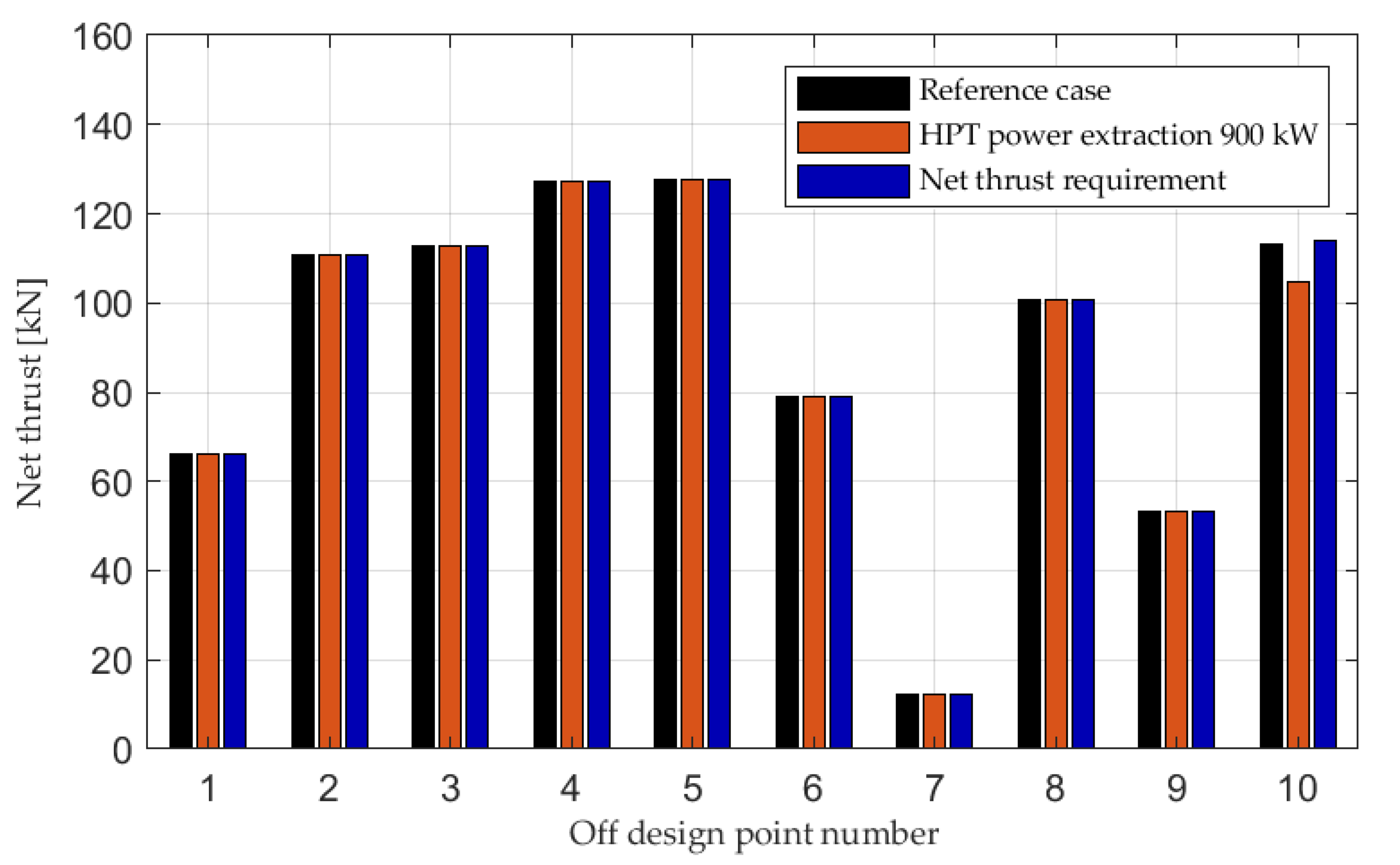


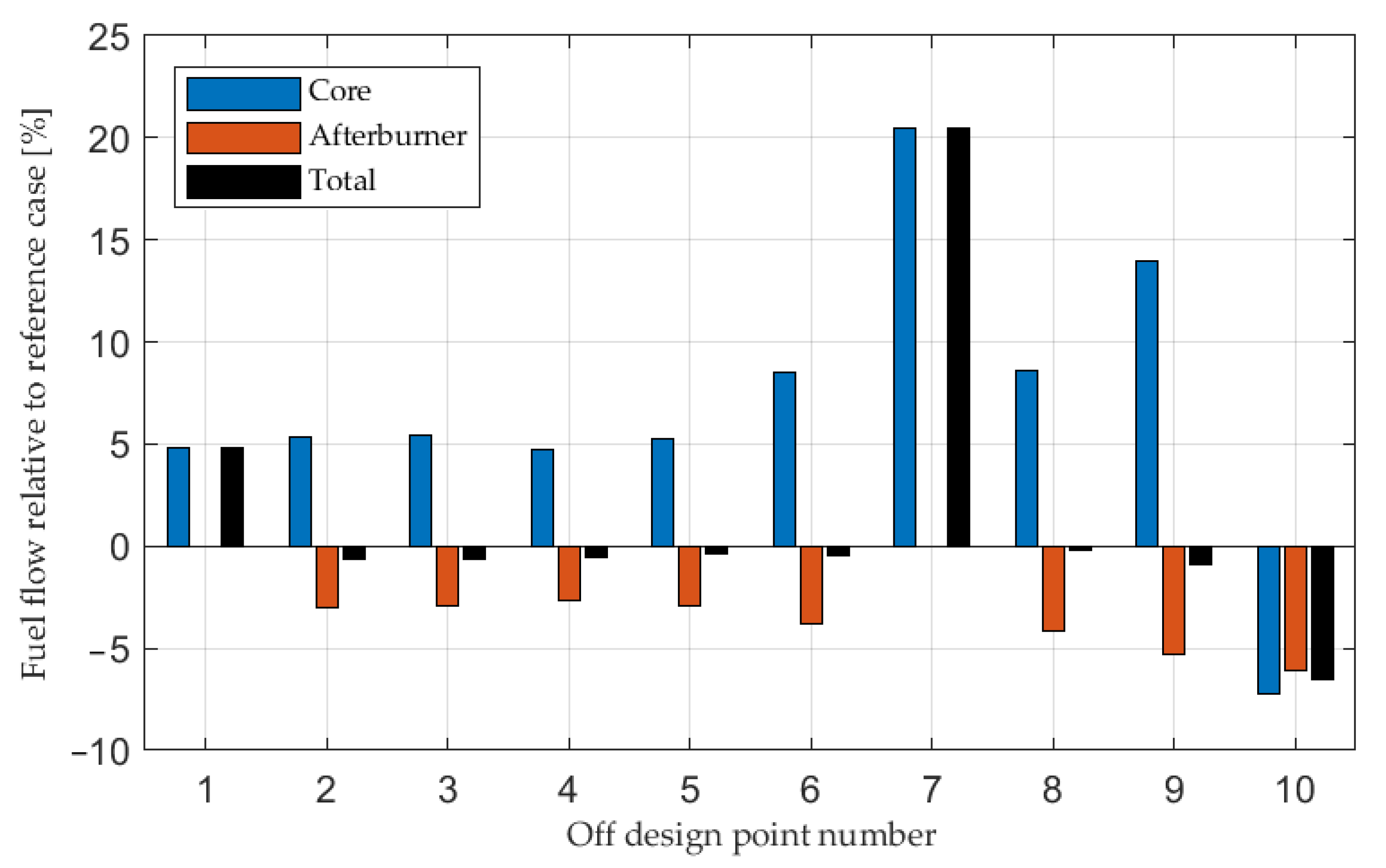

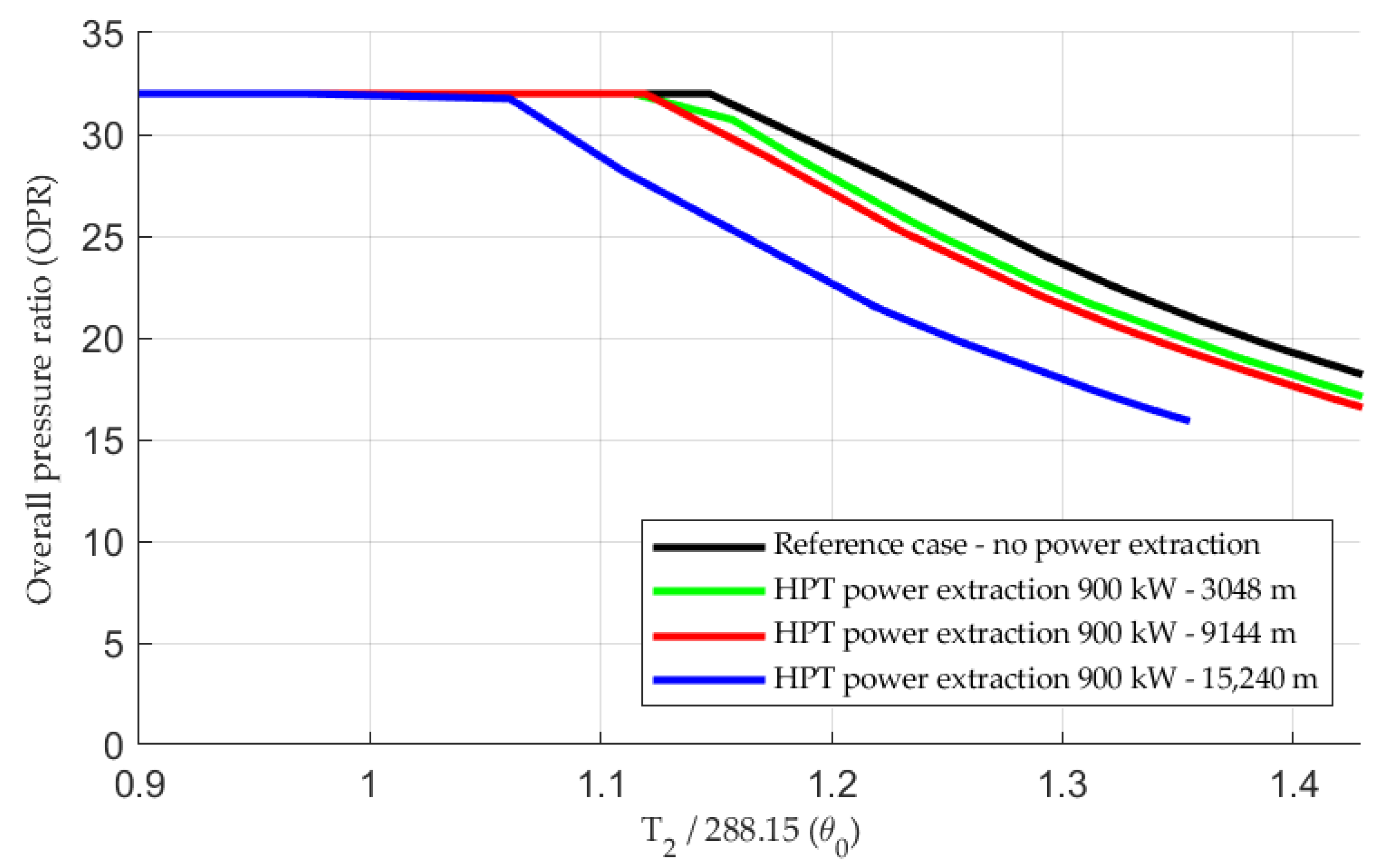
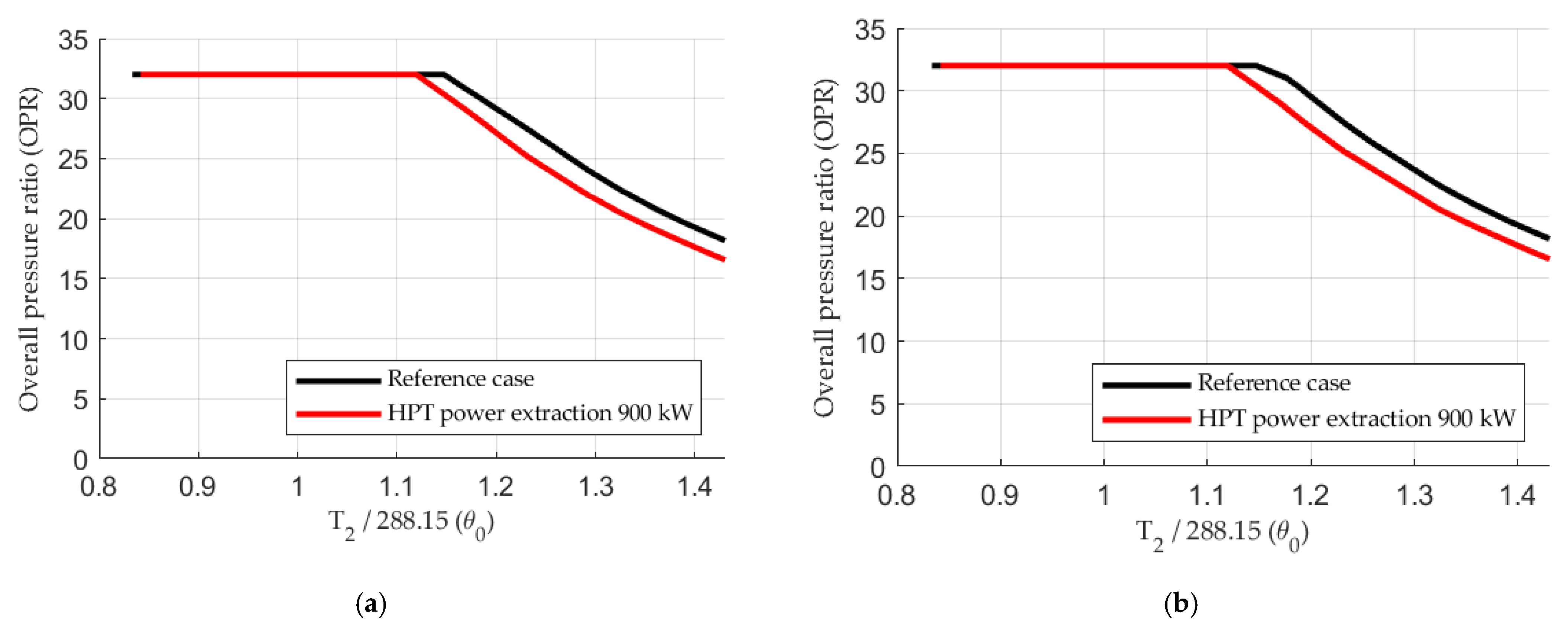
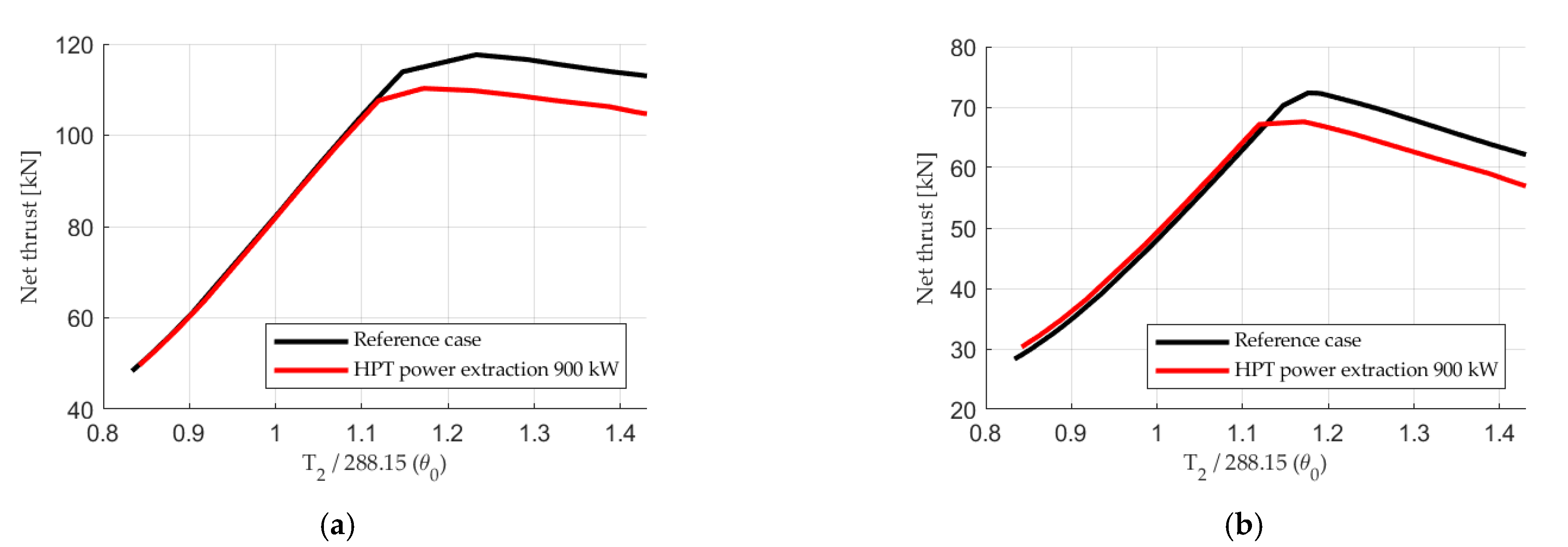
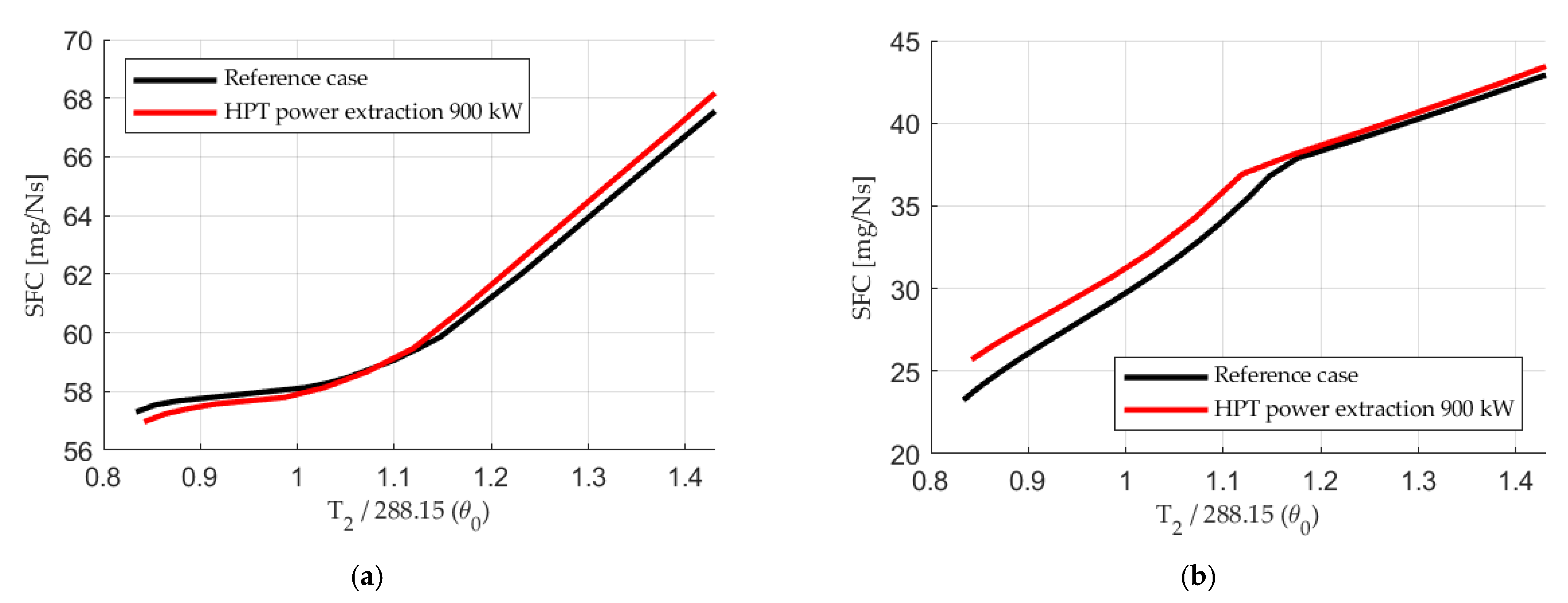

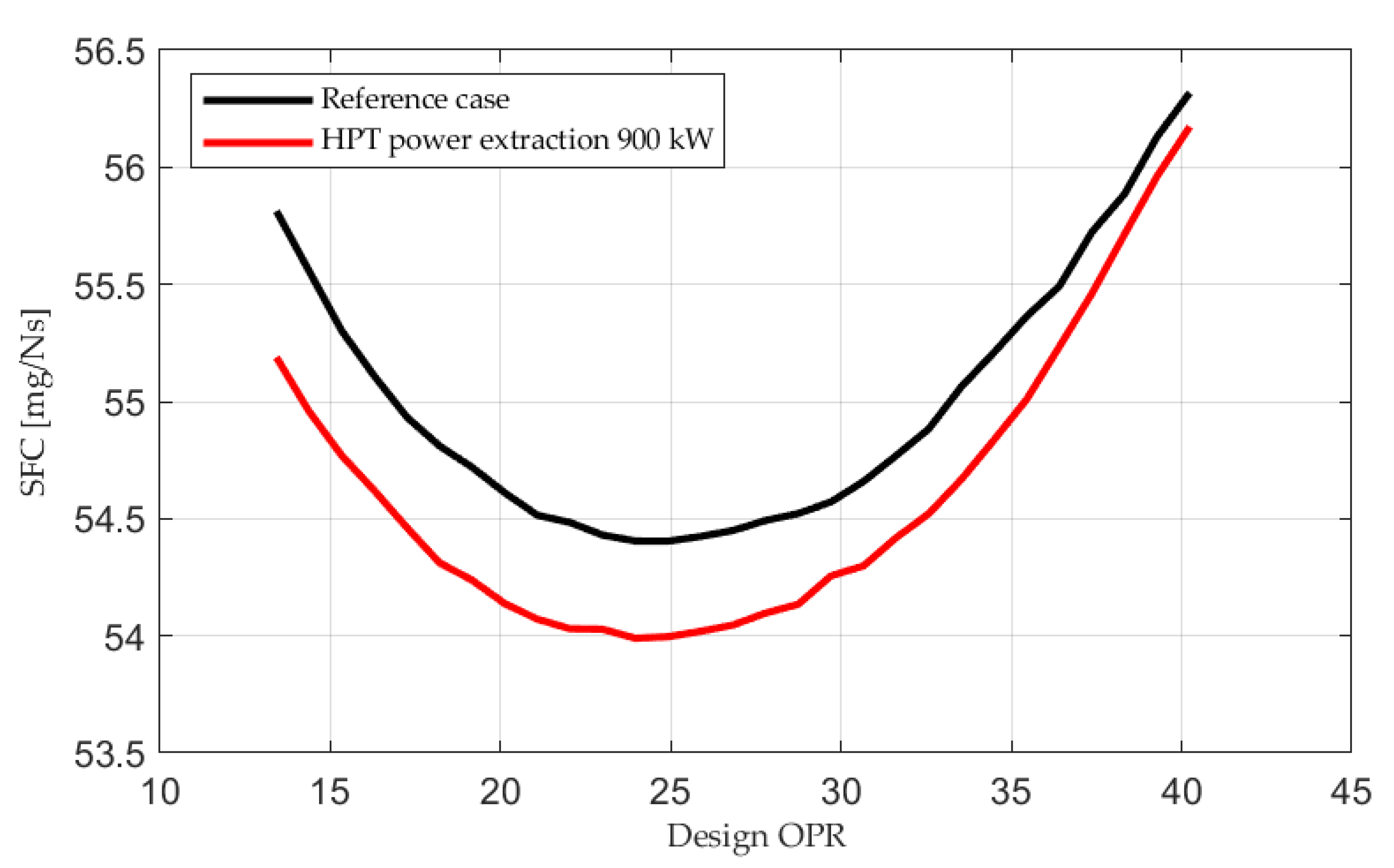
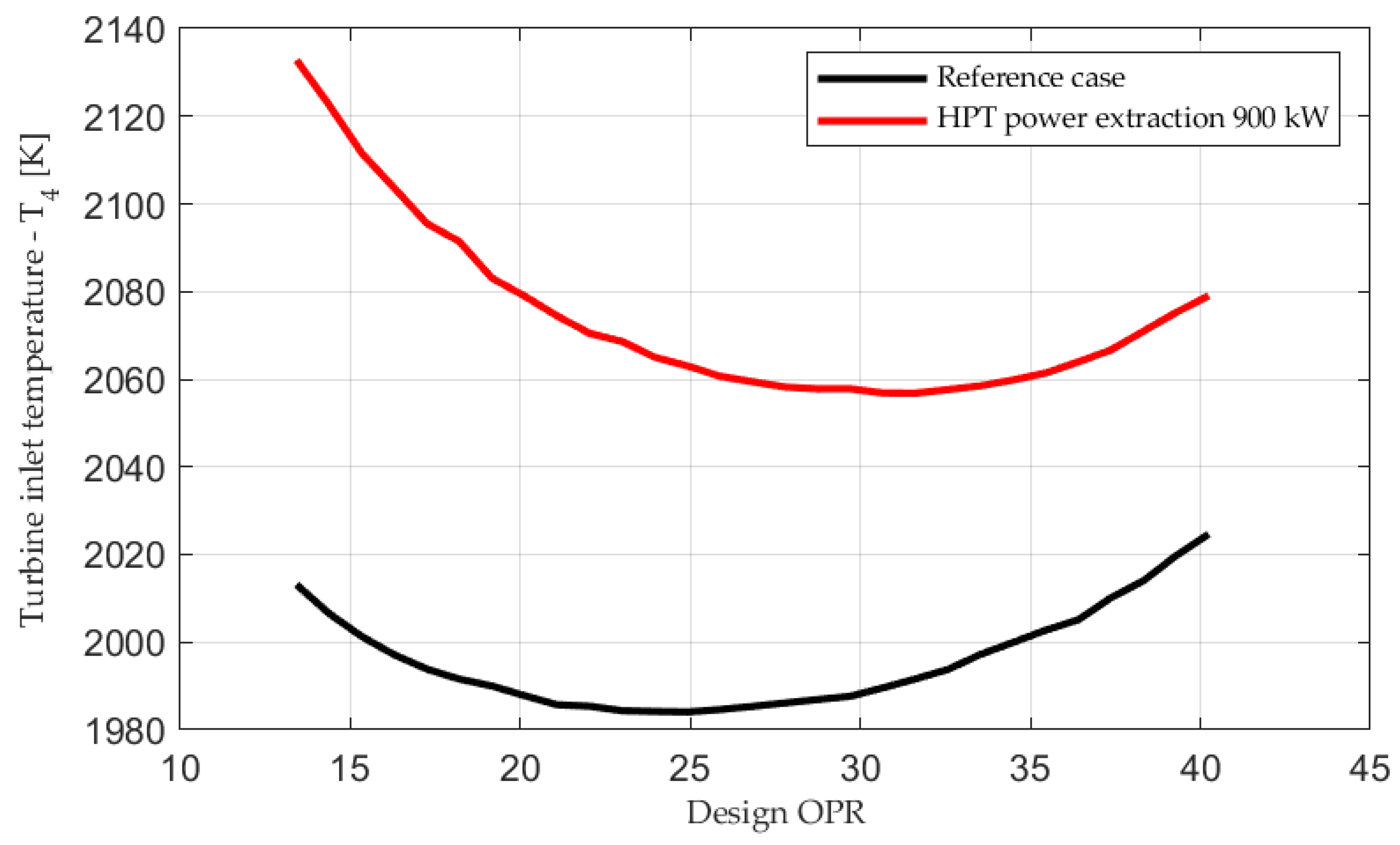
| Iteration Variables | Residuals |
|---|---|
| Inlet mass flow | Inlet flow compatibility |
| Fan map β | Core flow compatibility |
| Fan rotation speed | Fan/LPT work compatibility |
| Bypass ratio | HPC/HPT work compatibility |
| HPC map β | HPT inlet flow compatibility |
| HPC rotation speed | LPT inlet flow compatibility |
| Fuel schedule factor βf | Static pressure match in unifier |
| HPT outlet pressure | Afterburner flow compatibility |
| LPT outlet pressure | Engine control residual |
| No | Mission Phase | Required Net Thrust | Altitude | Mach Number |
|---|---|---|---|---|
| 1 | Warm up non-augmented | 66.0 kN | 610 m | 0.0 |
| 2 | Runway acceleration augmented | 110.7 kN | 610 m | 0.1 |
| 3 | Runway acceleration augmented | 112.9 kN | 610 m | 0.18 |
| 4 | Flight acceleration augmented | 127.3 kN | 610 m | 0.44 |
| 5 | Climb and acceleration augmented | 127.8 kN | 2743 m | 0.775 |
| 6 | Climb and acceleration augmented | 78.9 kN | 7010 m | 0.9 |
| 7 | Subsonic cruise non-augmented | 12.4 kN | 7010 m | 0.9 |
| 8 | Sustained turn augmented | 100.6 kN | 9144 m | 1.6 |
| 9 | Sustained turn augmented | 53.2 kN | 9144 m | 0.9 |
| 10 | Escape dash augmented | 113.9 kN | 9144 m | 2.0 |
| Parameter | Value |
|---|---|
| Altitude | 0 m |
| Mach number | 0 |
| Fan pressure ratio | 5.4 |
| HPC pressure ratio | 5.8 |
| Inlet mass flow | 90 kg/s |
| Turbine inlet blade temperature | 1030 K |
| Bypass ratio | 0.45 |
| Turbine inlet gas temperature | 1950 K |
| Bleed flow | 0 kg/s |
| LPT power extraction | 0 kW |
| HPT power extraction | 0 kW |
| Parameter | Value |
|---|---|
| Altitude | 0 ft |
| Mach number | 0 |
| Inlet mass flow | 90 kg/s |
| Turbine inlet blade temperature | 1030 K |
| Bypass ratio | 0.4 |
| Turbine inlet gas temperature | 2025 K |
| Bleed flow | 0 kg/s |
| LPT power extraction | 0 kW |
| HPT power extraction | 0 kW |
Publisher’s Note: MDPI stays neutral with regard to jurisdictional claims in published maps and institutional affiliations. |
© 2022 by the authors. Licensee MDPI, Basel, Switzerland. This article is an open access article distributed under the terms and conditions of the Creative Commons Attribution (CC BY) license (https://creativecommons.org/licenses/by/4.0/).
Share and Cite
Rosell, D.; Grönstedt, T. Design Considerations of Low Bypass Ratio Mixed Flow Turbofan Engines with Large Power Extraction. Fluids 2022, 7, 21. https://doi.org/10.3390/fluids7010021
Rosell D, Grönstedt T. Design Considerations of Low Bypass Ratio Mixed Flow Turbofan Engines with Large Power Extraction. Fluids. 2022; 7(1):21. https://doi.org/10.3390/fluids7010021
Chicago/Turabian StyleRosell, Daniel, and Tomas Grönstedt. 2022. "Design Considerations of Low Bypass Ratio Mixed Flow Turbofan Engines with Large Power Extraction" Fluids 7, no. 1: 21. https://doi.org/10.3390/fluids7010021
APA StyleRosell, D., & Grönstedt, T. (2022). Design Considerations of Low Bypass Ratio Mixed Flow Turbofan Engines with Large Power Extraction. Fluids, 7(1), 21. https://doi.org/10.3390/fluids7010021





